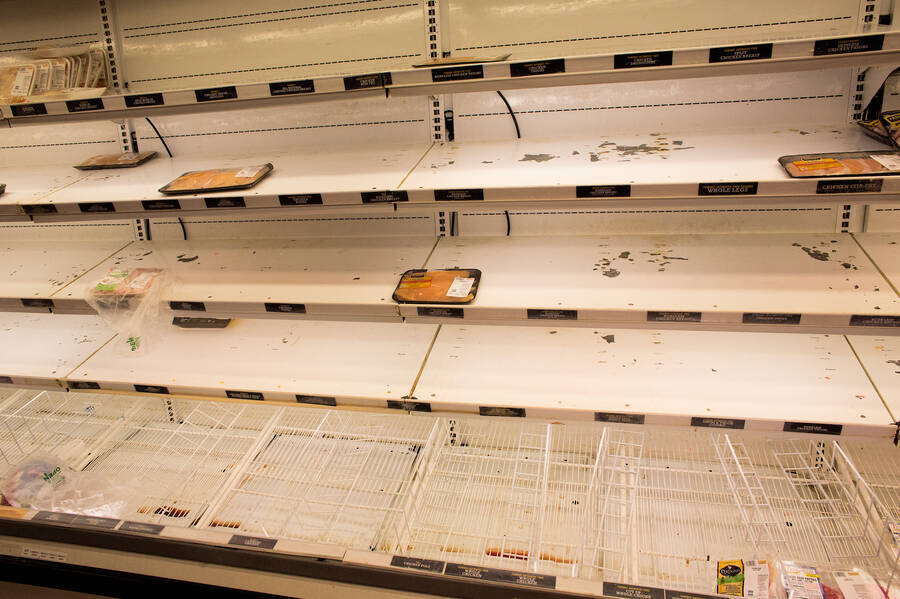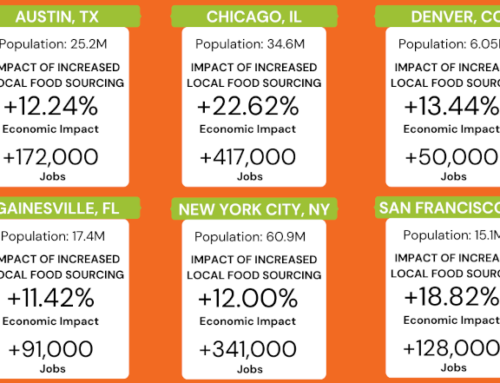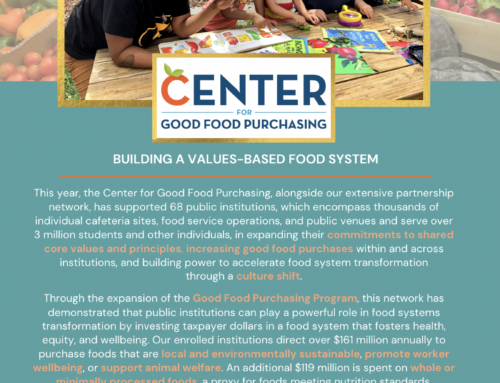What Can the Biden Admin Do to Make Our Food System More Resilient? Make it More Local.
Ben Lilliston
Editor’s Note: Writer Ben Lilliston is the director of rural strategies and climate change at the Institute for Agriculture and Trade Policy.
An under-the-radar executive order signed by the Biden administration in late February could have big implications for our food system. Biden’s order called for more “resilient, diverse and secure supply chains” and asked federal departments, including the U.S. Department of Agriculture (USDA), to submit recommendations to achieve this goal. A deep examination of food supply chains and their current vulnerabilities is long overdue.
The Biden supply chain executive order comes on the heels of a series of food supply chain disruptions during the Covid-19 pandemic and trade fights brought by the Trump administration. Over the last several years, climate-related severe weather events, from hurricanes to wildfires, have hit farmers and supply chains in different parts of the country. The current severe drought in the western part of the country poses an immediate risk. The latest U.S. Drought Monitor reports that 41% of corn, 89% of durum wheat, 86% of spring wheat, 51% of the hog inventory and 63% of dairy cow inventory are in areas experiencing drought.
Our food supply chains are a product of deliberate policy choices made within the Farm Bill, trade, labor, health, environmental, antitrust and competition policies and enforcement. To make supply chains more resilient will require a clear-eyed view of what outcomes we want, and what policy changes are necessary to get there. The Institute for Agriculture and Trade Policy (IATP) believes there are clear vulnerabilities to dependence on long (often global), highly concentrated supply chains controlled by multinational companies that are not motivated by the public interest. A more decentralized system, with increased redundancy combined with regional or local ownership, can be more accountable to public interest goals for a fair, environmentally sustainable, healthy food system.
In accordance with the Biden supply chain executive order, the USDA asked the public for ideas on how existing programs and priorities could support more resilient food supply chains. IATP’s submitted comments this week focused on four key areas.
Address excess corporate concentration
The loss of competition and concentrated corporate control in many sectors of our food supply chain hurt farmers and producers, workers and consumers. Some costs are being calculated as major poultry, pork and beef companies face a series of price-fixing investigations for collusion. While price fixing affects consumers, recently settled cases have involved conspiracies to depress wages for workers and payments to poultry farmers. The recent cyber-attack of JBS Foods, which controls 20% of U.S. beef processing, raised new vulnerabilities of such a concentrated system.
The tight corporate control over the meat supply came to the fore during the pandemic, as these global companies warned of shortages to U.S. supplies even as they expanded exports. The lack of reliable, transparent information about the U.S. meat supply during the pandemic was alarming and revealed an enormous vulnerability. IATP recommended that the USDA examine whether its Cold Storage survey data is adequate to assess meat supplies for the nation, what percentage of meat in storage and production is headed for export, and what additional information is needed to better understand supplies and associated risk.
IATP also called on USDA to do the following:
• Reinstate the Grain Inspection Packers and Stockyards Administration (GIPSA) as a stand-alone agency within USDA.
• Reopen rulemaking to strengthen farmers’ rights to challenge unfair or deceptive practices by companies and ensure fairness in poultry contracts.
• Close loopholes in regulations for voluntary country of origin labels to require that meat displaying a U.S. label verifiably comes from animals that were born, raised and slaughtered in the U.S. and work with Congress to reinstate mandatory country of origin labeling for meat and expand it to include dairy products.
• Investigate and address alarming trends in live cattle futures and beef markets that require immediate attention.
Risks from animal factory farms
While pandemic-related shutdowns of meatpacking plants affected workers, it also impacted the large-scale concentrated animal feeding operation (CAFO) system that supplies livestock to those plants. Both farmers and animals paid a price and would remain vulnerable if new shutdowns were to occur. A massive culling of millions of poultry and hogs was necessary when mega processing plants closed even for a few weeks. Producers had nowhere to take their animals because global companies have run most small and mid-sized meat processing plants out of business over the last several decades. The loss of small and mid-sized processing plants hurts larger CAFO producers, but it also hurts smaller scale producers, who during Covid-19 were also closed out of their traditional processors. These smaller-scale producers now face wait times of over a year to get their animals to their traditional processor, incurring more feeding costs and animal health risks during the prolonged wait.
The Covid-19 outbreak is only the latest example of the enormous and growing risk associated with a factory farm system of animal production. Multiple hurricanes have hit a cluster of factory farms in North Carolina over the past decade, while torrential rains and resulting flooding have damaged Iowa factory farms. Each weather event has resulted in CAFO manure lagoon breaches, manure spills and water pollution.
In addition to supporting a more diverse meat processing system, IATP called on the USDA to stop subsidizing new and expanding existing CAFOs through conservation and guaranteed loan programs, and to require stronger environmental review for any publicly-backed loans.
Essential food system workers
The alarming number of Covid-19 outbreaks, and resulting deaths and illnesses, among food system workers, often people of color, throughout the supply chain exposed several fundamental weaknesses. The breakdowns also revealed the lack of protections and agency these workers, often immigrants or refugees, have when exposed to a health threat, and the absence of a strong regulatory system to protect workers throughout the supply chain.
Given the Occupational Safety and Health Administration’s (OSHA) resistance to regulating to protect food system workers during the pandemic, it was alarming to see the USDA allow increased line speeds, further increasing risks for workers. IATP called for the USDA to work more closely with OSHA, the Environmental Protection Agency and The Centers for Disease Control and Prevention to assess the risks to essential food systems workers from the farm to the grocery store. Then the agencies should use their respective authorities and assessments to protect these workers.
Reforms to food and farm programs
Supply chain resilience has not been a primary focus of Farm Bill programs, but IATP highlighted several opportunities for reforms:
- USDA-backed farm lending currently does not integrate climate-related risk and supply chain resilience into lending terms, nor does it coordinate lending with relevant technical assistance to reduce those risks. Federally subsidized crop and livestock insurance policies could be written to reduce premiums and increase indemnification payouts for farmers and ranchers who comply with practices to reduce their climate-related risk exposures.
- A reformed and updated supply management system could achieve multiple goals that strengthen supply chains, including storing grains in times of oversupply, providing farmers with predictable parity price levels, incentives for more climate-resilient farming and food systems.
- When considering resilience of food production supply chains in the U.S., soil health should be a foundational pillar. The USDA should make improving soil health a national-level priority following well-recognized soil health principles used by the Natural Resource Conservation Service (NRCS): 1) keep the ground covered; 2) as little disturbance as possible; 3) increase crop diversity; 4) keep living roots in the soil; 5) integrate livestock.
- Greater public investments to strengthen and build out regional food systems including renewed investments in Value Added Producer Grants, Farmers Market and Local Food Promotion Program and Regional Food Systems Partnership program.
- Support resilience through USDA purchasing, including school food program, by implementing standards for procurement established by the Center for Good Food Purchasing and the Real Food Challenge. These successful models could be the basis for a reformed federal food procurement program that integrates food system resilience, health, fairness and environmental sustainability.
- USDA should work with other federal agencies to stop the use of PFAS-contaminated wastes and compost as soil amendment and take a leadership role to establish limits for PFAS in common food and food products including milk and related products (e.g., cheese and yogurt), meats, poultry, vegetables, fruit and animal feed. USDA should expand and enhance the existing Dairy Indemnity Payment Program (DIPP) so that it can address the needs of PFAS-affected dairy farmers and establish a new financial support fund for PFAS contaminated farms (not limited to dairy).
Developing a new policy framework focused on building more resilient food system supply chains is long-overdue. Recent events have exposed the significant risks from granting control of food supply chains to multinational companies (including those with U.S. headquarters) that have a fundamentally different set of priorities than those of any nation, region or community. We look forward to tracking how the USDA and Congress address these risks, while supporting “resilient, diverse and more secure supply chains.”





